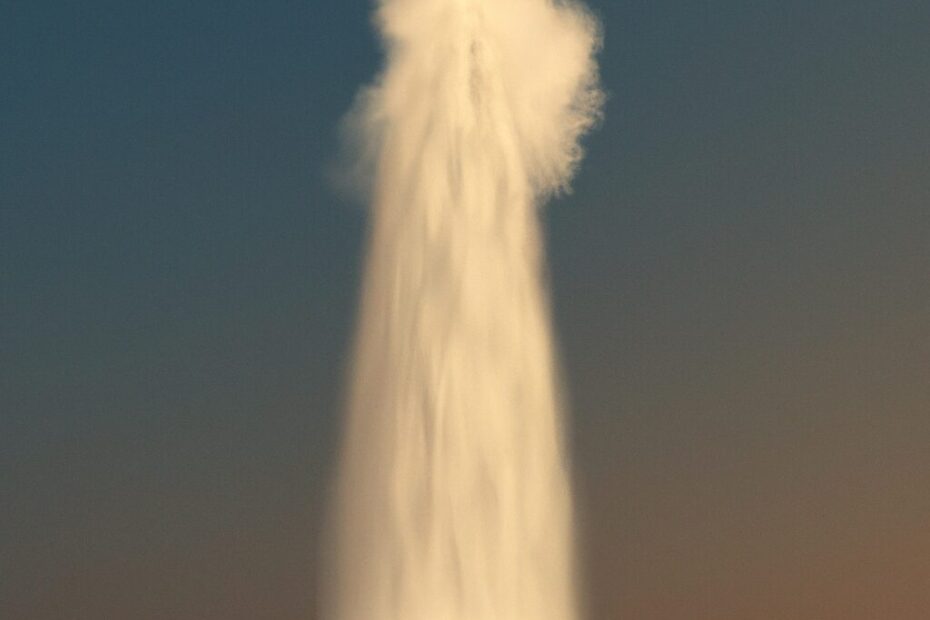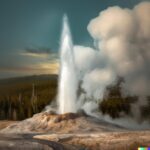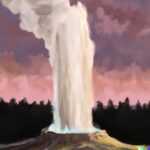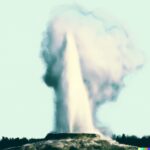Geysers, these natural wonders that shoot out hot water and steam, have fascinated scientists and visitors alike for centuries. But have you ever wondered how these geysers are formed and what causes their powerful eruptions?
In this article, we will explore the science behind geysers and delve into the methods scientists use to predict when these incredible natural phenomena will erupt. From monitoring water temperature to studying historical eruption patterns, we will uncover the challenges and complexities of predicting geyser eruptions.
So, buckle up and get ready to dive into the mesmerizing world of geysers.
What Are Geysers?
Geysers are hydrothermal systems found worldwide that exhibit periodic eruptions of steam and hot water.
These unique hydrothermal systems are commonly associated with volcanic regions due to the proximity of magma to the Earth’s surface, allowing for the heating of groundwater and the creation of intense pressure within underground chambers.
The global distribution of geysers includes well-known examples such as Old Faithful in Yellowstone National Park in the United States, the Great Geysir in Iceland, and the Pohutu Geyser in New Zealand.
Geysers typically erupt in cycles, with periods of quietude followed by powerful bursts of steam and water propelled high into the air due to the sudden release of pressure from built-up gases.
How Are Geysers Formed?
Geysers are formed through a combination of underground water reservoirs with elevated temperatures and substantial underground pressure.
These unique natural wonders typically occur in regions with specific geological features that contribute to their formation. The process begins as rainwater seeps underground and is heated by geothermal energy from the Earth’s core. As the water heats up, it becomes less dense and rises through cracks and fissures in the Earth’s crust. The pressure from the surrounding rocks and the build-up of steam below the surface eventually lead to the explosive release of hot water and steam, resulting in the spectacular eruption that characterizes a geyser.
What Causes Geyser Eruptions?
Geyser eruptions are primarily triggered by the accumulation of underground steam and water pressure, following distinct eruption patterns often associated with seismic activity.
As underground water and steam continue to percolate in the geyser’s plumbing system, immense pressure builds up over time. When the pressure exceeds the strength of the overlying rock and sediments, it results in a sudden release of steam and water, propelling the explosive eruption. The unique eruption patterns of geysers, characterized by intermittent bursts of water and steam, are influenced by the intricate interplay between the underground geological structures and the external factors like seismic activity. Volcanic activity in the vicinity can further contribute to the disturbances in the geyser’s hydrothermal system, potentially triggering more frequent or intense eruptions.
Heat Source
The heat source for geyser activity stems from geothermal processes within the Earth’s crust, driven by magma movements and the dynamic heat exchange in the planet’s interior.
These geothermal processes play a crucial role in the formation and eruption of geysers. When magma beneath the Earth’s surface heats up water in underground reservoirs, pressure builds up until the water and steam forcefully erupt through vents, creating the spectacular displays often seen in geyser eruptions. This intricate interplay between the Earth’s internal heat and water circulation gives rise to the mesmerizing natural phenomena that captivate scientists and visitors alike, showcasing the powerful forces at work beneath the Earth’s surface.
Confining Pressure
Confining pressure underground, coupled with vapor pressure buildup, plays a critical role in geyser eruptions as pressure fluctuations within the hydrothermal system lead to explosive releases of steam and water.
These pressure dynamics are influenced by the interactions of magma with groundwater deep beneath the surface, creating a complex interplay of forces that contribute to the intensity of the eruptions. The gradual accumulation of heat and pressure from below provides the energy necessary for the sudden surges of boiling water and steam that characterize geyser activity. This build-up of pressure often results in a mesmerizing display of nature’s power, showcasing the intricate balance between subterranean forces and surface manifestations.
Groundwater Supply
The availability and interaction of groundwater within hydrothermal systems are essential factors in sustaining geyser eruptions, influenced by water chemistry analysis and complex groundwater interactions.
Groundwater plays a crucial role in the formation of geysers, as it seeps into the Earth’s crust and interacts with hot rocks deep underground. Through water chemistry analysis, researchers gain insights into the mineral composition of the groundwater, which affects the dynamics of hydrothermal systems. Understanding these interactions is vital for predicting geyser activity and ensuring the sustainable management of geothermal reservoirs. Groundwater movement within these systems creates pressure changes that can trigger eruptions, making it a key component in the study of geysers.
What Are the Signs of a Geyser Eruption?
Signs of an impending geyser eruption may include seismic activity in the vicinity, anomalies detected through thermal monitoring, and variations in thermal signatures.
Geysers provide distinct clues before an eruption, often marked by increased seismicity caused by the movement of magma beneath the surface. Thermal monitoring techniques play a crucial role in tracking the subtle changes in temperature patterns, as rising heat can cause alterations in the surrounding environment. The detection of thermal anomalies, such as sudden spikes in surface temperatures or changes in gas emissions, serves as a critical indicator of potential geyser activity. Understanding these geophysical signals is essential for predicting and preparing for geyser eruptions.
Increased Water Temperature
A significant increase in water temperature is a key precursor to a geyser eruption, often indicating imminent volcanic activity and requiring detailed water chemistry analysis to predict eruption triggers.
By monitoring thermal anomalies and utilizing geothermal sensors, researchers can capture and analyze fluctuations in water temperature patterns. This data plays a critical role in understanding the underlying processes leading to geyser eruptions, as changes in water chemistry can offer valuable insights into the mechanisms that trigger these natural phenomena. The analysis of water composition, including the presence of minerals and gases, can provide early warnings of potential volcanic disruptions, aiding in the development of effective mitigation strategies.
Changes in Water Levels
Fluctuations in water levels within hot springs and associated groundwater interactions can signify the onset of a geyser eruption, often accompanied by observable ground deformation in the surrounding area.
These changes in water levels serve as a reliable indicator of the hydrothermal reservoir’s activity beneath the Earth’s surface. As pressure builds up within the reservoir, it can lead to fluctuations in the water levels of the hot springs, signaling the potential release of steam and water through the geyser’s vent. The ground deformations that accompany these fluctuations are a result of the movement of subsurface fluids and the shifting of rocks caused by the changing pressure dynamics. Monitoring these variations in water levels and ground movements is crucial for understanding the behavior of geysers and predicting potential eruptions.
Changes in Ground Movement
Alterations in ground movement patterns, as evidenced by geophysical signals and observable deformations, may signal an impending geyser eruption linked to underlying tectonic activity in the region.
These geophysical signals may include variations in ground elevation, changes in seismic activity, and alterations in thermal activity beneath the Earth’s surface. These changes often occur due to the shifting of tectonic plates, which can lead to an increase in pressure and eventual release through geyser eruptions. Monitoring these ground movements can provide valuable insights into the behavior of geysers and help predict potential eruptions, contributing to the understanding of geothermal systems and volcanic processes.
How Do Scientists Predict Geyser Eruptions?
Scientists employ predictive technology and advanced data analysis methods to forecast geyser eruptions, with specific focus on renowned geysers like those in Yellowstone National Park.
By utilizing geothermal monitoring networks and sophisticated geothermal sensors, researchers gather real-time data on factors such as water temperature, pressure, and seismic activity that indicate potential geyser activity.
This data is then analyzed to identify patterns and trends that can help predict the timing and intensity of eruptions, offering valuable insights into the behavior of these natural wonders.
Through a combination of cutting-edge technology and in-depth analysis, scientists continue to refine their predictive models to enhance their ability to anticipate geyser eruptions with greater accuracy.
Monitoring Water Temperature
Continuous monitoring of water temperature through thermal sensors is a crucial aspect of geyser eruption forecasting, enabling scientists to predict eruption events with greater accuracy.
By tracking thermal anomalies in the water surrounding geysers, researchers are able to identify patterns and trends that may indicate an impending eruption. Understanding the relationship between water temperature fluctuations and eruption probabilities plays a key role in studying geyser behavior. These thermal monitoring techniques provide valuable data that can help predict the timing and severity of geyser eruptions, ultimately contributing to public safety and advancing scientific understanding of geothermal processes.
Measuring Ground Movement
Measuring ground movement and tracking groundwater interactions provide critical data for geyser eruption forecasts, allowing for real-time updates on eruption probabilities and associated risks.
By analyzing geospatial data gathered through monitoring devices, scientists can detect subtle changes below the Earth’s surface that may indicate an impending eruption. Regular updates on ground movement measurements are crucial as they offer valuable insights into the dynamic interactions between groundwater and volcanic activity.
Real-time monitoring systems play a pivotal role in providing timely alerts to communities living near active volcanic areas, helping to mitigate potential hazards and ensure public safety. The integration of advanced technologies in eruption prediction has revolutionized our ability to monitor and forecast volcanic events with greater accuracy and efficiency.
Studying Historical Eruption Patterns
Analyzing historical eruption patterns, including those from geysers in Iceland, offers valuable insights for scientists in developing predictive models and refining eruption forecasts.
The data collected from past geyser eruptions in Iceland can reveal crucial information about the eruption dynamics, such as frequency, duration, and intensity. By recognizing the patterns in these historical records, researchers can better understand the factors that influence geyser behavior and improve their ability to anticipate future eruptions.
This historical perspective allows scientists to evaluate the impact of various geological and environmental factors on geyser activity, leading to more accurate predictions and potentially mitigating the risks associated with unexpected eruptions.
What Are the Challenges of Predicting Geyser Eruptions?
Despite advancements in predictive technology, the challenges of accurately forecasting geyser eruptions persist, necessitating improved public safety measures and enhanced geothermal mapping.
One of the major hurdles in predicting geyser eruptions is the unpredictable nature of geothermal activity beneath the Earth’s surface. Factors such as shifting tectonic plates and underground reservoirs make it difficult to pinpoint exactly when a geyser will erupt. This unpredictability poses a significant challenge for disaster preparedness efforts. Without accurate forecasts, authorities struggle to implement timely evacuation plans and emergency response strategies.
Geothermal mapping plays a crucial role in assessing eruption risks by identifying high-risk zones and providing valuable data for disaster prevention initiatives.
Unpredictable Factors
The presence of unpredictable factors such as subtle natural indicators, varied eruption precursors, and geophysical anomalies complicates the accurate prediction of geyser eruptions.
These elements challenge scientists and researchers in forecasting when a geyser might erupt. Natural indicators like changes in water temperature, ground deformation, and seismic activity offer clues, but their patterns can be inconsistent. Geophysical anomalies such as shifts in hydrothermal systems also play a crucial role in eruption events. Understanding these complexities is key to improving eruption prediction models and enhancing our knowledge of the dynamic interactions within geysers.
Lack of Monitoring Equipment
The scarcity of advanced geothermal sensors and monitoring equipment poses a significant challenge in accurately assessing geyser eruption risks and limits the effectiveness of geophysical modeling.
This lack of adequate monitoring tools hinder the ability to predict when and where potential geyser eruptions may occur, thus impeding the overall risk assessment process. Without real-time data from sophisticated geothermal sensors, scientists and researchers face difficulties in creating precise geophysical models to understand the underlying mechanisms of geyser formation.
Improved availability and utilization of monitoring equipment can not only enhance the accuracy of predicting geyser activities but also contribute to the advancement of geothermal energy exploration and utilization. By investing in and deploying innovative sensor technologies, the geothermal industry can better optimize resource extraction and improve overall operational efficiency.
Limited Understanding of Geyser Behavior
The limited understanding of geyser behavior, despite ongoing research studies and predictive modeling efforts, hampers the accurate assessment of critical factors like vapor pressure buildup that precede eruptions.
This challenge underscores the significance of delving deeper into the complexities of geyser dynamics to develop effective eruption mitigation strategies. By unraveling the intricate interplay between geological features, hydrothermal systems, and external triggers, researchers aim to enhance the accuracy of eruption predictions.
The impacts of geyser eruptions, such as environmental disruptions and potential hazards to nearby communities, highlight the necessity for comprehensive research initiatives that integrate both theoretical modeling and empirical data. Addressing these challenges can pave the way for more proactive measures to mitigate the risks associated with geyser activity.
Last Updated on February 11, 2024 by Jon Waraas – Originally Posted: February 11, 2024

I’m Jon Waraas, and I’ve been navigating the online world since 2006. By day, I’m the proud owner of some eCommerce gems, and by night, I’m the voice behind the adventures on Waraas.Com.
My heart, however, belongs to the wild beauty of Yellowstone National Park. I’ve got a collection of websites dedicated to sharing the wonders of this natural masterpiece. Oh, and did I mention? I’m currently building my own cabin inside the ghost town of Gilmore, Idaho – a cabin with tales to tell!
When I’m not immersed in the digital realm, you’ll find me lacing up my boots for a good hike or setting up camp under the star-studded sky.




